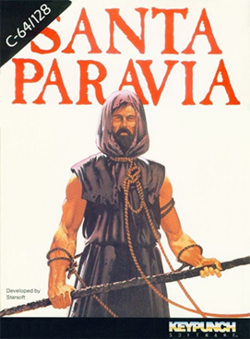Software:Santa Paravia en Fiumaccio
| Santa Paravia en Fiumaccio | |
|---|---|
 | |
| Designer(s) | George Blank |
| Platform(s) | TRS-80, TI-99/4A, Apple II, Commodore PET, Atari 8-bit,[1] Amiga, Atari ST, Commodore 64/128, DOS |
| Release | 1978 |
| Genre(s) | City-building |
| Mode(s) | Single-player, multiplayer |
Santa Paravia en Fiumaccio is a video game in which each player becomes the ruler of a fledgling Italian city-state around the year 1400. The goal of the game is to become king or queen;[2] to do so the player must manage their city-state so that it may grow.
The game, by George Blank,[3] first appeared in the December 1978 issue of SoftSide magazine,[4] (Milford, NH), and was published for sale on tape cassette as a computer game by Instant Software (Peterborough, NH) for the Radio Shack TRS-80, Apple II, TI-99/4A, and Commodore PET.[5] It has been translated into many languages, such as ANSI C,[6] and has been ported to the Palm Pilot.
Gameplay
The game consists of yearly turns, beginning in 1400; each turn involves the allocation of grain, counted in steres, and funds, counted in florins, attempting to grow the colony in both population and size. A ruler must ensure that sufficient grain supplies are available to feed his people; by distributing excess grain, a ruler can encourage more citizens to move into his city-state. However, often famine and rats cause grain reserves to diminish.
Funds can be spent to purchase more land, military forces, or various types of structures. These structures include revenue producing mills and markets as well as prestigious palaces and cathedrals. (The 'SoftSide' version had a code error that allowed you to keep all your grain, even when you went bankrupt.)
The different social classes present in this game are serfs, clergy, merchants and nobility.
Based loosely on the text game Hamurabi, Santa Paravia and Fiumaccio was an early god game. It combined 'guns and butter' economic tradeoffs with graphic development of a kingdom with buildings being constructed and shown on the screen as well as character development, shown as progressive promotions[7] from baron to king.
Reviews
- Moves #56, p27[8]
See also
- Dukedom, a 1976 fief management game
- Dynasty, a 1978 province management game set in the Hunan under the Yuan dynasty
- Hamurabi, a 1968 city management game
References
- ↑ "Santa Paravia and Fiumaccio". http://www.atarimania.com/game-atari-400-800-xl-xe-santa-paravia-and-fiumaccio_4498.html.
- ↑ The Software Catalog. Elsevier. 1983. pp. 172. ISBN 978-0-444-00745-2. https://books.google.com/books?id=1VdVAAAAMAAJ&q=%22Santa+Paravia%22. Retrieved 2008-09-13.
- ↑ Peterson, Dale (1983). Genesis II, Creation and Recreation with Computers. Reston Pub. Co.. pp. 182. ISBN 978-0-8359-2434-4. https://books.google.com/books?id=DL1YAAAAMAAJ&q=%22Santa+Paravia%22. Retrieved 2008-09-13.
- ↑ Blank, George (December 1978). "Santa Paravia en Fiumaccio". SoftSide. https://archive.org/stream/softside-magazine-03/SoftSide_03_Vol_1-03_1978-12_Santa_Parvia#page/n7/mode/2up. Retrieved November 15, 2014.
- ↑ The Software Encyclopedia. Bowker. 1985. pp. 343. https://books.google.com/books?id=5-w6AAAAMAAJ&q=%22Santa+Paravia%22. Retrieved 2008-09-13.
- ↑ Knox, Thomas (November 29, 2003). "paravia.c". http://planet-source-code.com/vb/scripts/ShowCode.asp?txtCodeId=7183&lngWId=3.
- ↑ Engel, George M. (2007). The Naked Serviceman. Lulu.com. pp. 47. ISBN 978-1-4303-1785-2. https://books.google.com/books?id=6oXg8el9WdsC&q=%22Santa+Paravia%22&pg=PA47. Retrieved 2008-09-13.
- ↑ Moves Issue 56 Strategy and Tactics Press
External links
- "Santa Paravia – 2015". Versão Java desenvolvida por Manuel Afonso.. http://1drv.ms/1Sd2m9V.
- "Santa Paravia". MMReference. http://mmreference.com/product/santa-paravia/. (Source code of the game)
- "SantaParavia andFiumaccio 2003!". 2003. http://www.apple2.org.za/gswv/a2zine/Sel/SP.html.
- Santa Paravia en Fiumaccio at Gamebase 64
 |

